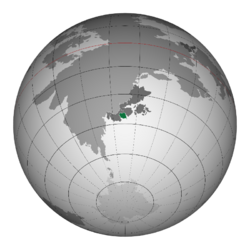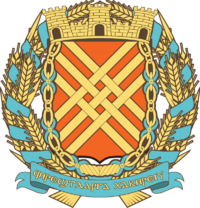Mannatiua
This article is incomplete because it is pending further input from participants, or it is a work-in-progress by one author. Please comment on this article's talk page to share your input, comments and questions. Note: To contribute to this article, you may need to seek help from the author(s) of this page. |
Vurthungrian Free Association of Communes Vurthungrian: 𐑜𐑷𐑯𐑷𐑕ß𐑭𐑥𐑤𐑯𐑛𐑧𐑯 𐑴'𐑓𐑴𐑮𐑑𐑯𐑜𐑰𐑮 (Traditional) Ganasdsåmlenden oFortungir (Aesculized) Innan: Þéodcyning Framscipe á Landen Vorþongerisc Escara: Associu Libera di Comuni Fortongrolu | |
|---|---|
| Motto: "Peace to all, death to tyrants!" | |
| Anthem: Unto The Breach | |
 | |
| Capital and largest city | Taradabourgh |
| Official languages | Vurthungrian |
| Recognised regional languages | Innan, Escara |
| Demonym(s) | Vurthungrian |
| Government | Libertarian Socialist Federation under a Unicameral Nonpartisan Consensual Soviet Democracy |
| Gerall Berrhe | |
| Olle Eldannadid | |
| Legislature | Revolutionary Federal Commissary |
| Formation | |
• Settlement by the Proto-Vurthungrian Vordons Culture | c. 650-300 BCE |
| 499-1137 CE | |
| 1221-1401 CE | |
| 1798 CE | |
| 1903 CE | |
| 1943 CE | |
| 1947 CE | |
| Area | |
• Total | 66,897.25 km2 (25,829.17 sq mi) |
| Population | |
• 2019 estimate | 21,442,089 |
• 2010 census | 19,989,772 |
• Density | 320.52/km2 (830.1/sq mi) |
| GDP (PPP) | 2019 estimate |
• Total | 219.24 Billion IRM |
• Per capita | 10,225 IRM |
| GDP (nominal) | 2019 estimate |
• Total | 384.39 Billion IRM |
• Per capita | 17,927 IRM |
| Gini (2016) | low |
| HDI (2017) | very high |
| Currency | Vurthungrian Bezond (28.37 VUB = 1 IRM) (VUB) |
| Date format | dd/mm/yyyy |
| Driving side | right |
| ISO 3166 code | VU |
| Internet TLD | .vu |
Vurthungria, officially styled the Vurthungrian Free Association of Communes, and occasionally abbreviated as the Free Association, is a country in Eastern Plateia. It is bordered to the east by Hoylend Bay and Aesculia, and to the west by the Bay of Furth and Vetonia. It is trisected by the branches of the Vordons River, generally divided, from east to west, into the historic regions of Hoylend, Ennalend, and Wardania. The nation's capital is Taradabourgh; other major cities include Bittabourgh and Bastia. With a territory of [TERRITORY], it is Plateia's [RANK] country, and the [RANK] in the world.
Since the adoption of its Constitution, Vurthungria has been organized as a voluntary federation founded upon the principles of Libertarian Socialist Communalism, the Non-aggression principle, and Consensus Democracy, making the terminology of conventional statehood highly contentious in reference to Vurthungria, while acting as a de facto sovereign state.
Vurthungria is a member of the International Coalition for Liberty.
While not a part of the Plateian Common Market, it is one of the chief exporters of machinery, minerals, and grain in the region. Since the liberalization of the Vurthungrian markets to allow for far less restrictive border crossings, it has become a major hub of tourism in Plateia, especially thanks to its high-quality environment, world-class winter sports sites, and numerous ancient megalithic structures and other historic regions.
Etymology
The name Vurthungria is derived from the Proto-Vurthungrian Vordons Gir, an alliance of tribes of [GOTHIC] origins which migrated and settled in the region of the modern Vurthungrian nation between the seventh and fourth centuries BCE, and are credited with its foundation. Their name is not entirely understood, and references to the Vordons Culture cannot be reliably traced past c. 300 BCE, making the location of primary sources which might determine its linguistic origins extremely difficult for modern scholars. It may have been rooted in the Innan term Wárdan Cynn ("strange deer people") in use as an exonym during the Vordons migrations in antiquity, in possible reference to headdresses worn by Vordons warriors adorned with the antlers of Red deer, as well as their noted reverence for the animal in their oral tradition.
Geography
Climate
Biodiversity
Political Geography
History
- Main Article: History of Vurthungria
Prehistory and Antiquity
The earliest habitation by modern humans of the region constituting modern Vurthungria took place around 11,000 BCE, as reindeer-hunting nomadic cultures entered the area during the recession of the Tennescösh Glacier which began two millennia earlier. Recent evidence suggests that a small population of Neanderthals resided in the southern portions of the country c. 150,000 BCE as well, though it is unlikely that the population survived to make contact with homo sapiens in the area due to a phase of glacial advance. The first sedentary agricultural societies in the area began to emerge around 4,500 BCE in the form of the Cushbåro Culture, which resided largely in the coastal lowlands and created a number of dolmens and megalithic tomb structures which are still observable today.
The Gattars, the primary non-[GOTHIC] ancestors to the Vordons, would establish themselves as the prominent culture in the region during the bronze age, and would be among the earliest metallurgists in the region of [NORTHEAST EUROPE], as well as noted charioteers and later, skilled horsemen.
First Kingdom
Second Kingdom
Aesculian Imperial Rule
Imperial Principality
Independence
Revolution and Early Anarchist Period
Main Articles: Vurthungrian Revolution
- Revolution begins in two waves - the Officers' Coup of February 1939 which established the short-lived Provisional Republic (effectively a military junta), and the Revolution of June 1943.
- The "Black Terror" of 1944 takes place primarily in major urban centers, with greatest effect in Innan-majority areas, which disproportionately supported the Officers' Coup and the Principality before it. As the International Coalition for Liberty begins to pull out of its alliance with the Authoritarian Leftists, Anarchists begin to target "Orthodox" Leftists as part of the campaign to "save the revolution" through to 1945, a period of violence known as the "Little Terror", which had a relatively small scope domestically.
- Tenemore Tarradh suffers a stroke in August 1945 and functional authority is passed to the leadership of Dauben Bitt, the head of the Black Army throughout the combat in support of and against the 1939 Coup. Tarradh is still the official figurehead of the Revolutionary Movement until his death in 1946, but makes no public appearances as his declining health is kept a secret to maintain morale.
Free Association of Communes
Politics and Government
Executive Ministry
- Main Articles: Executive Minister of Vurthungria, Executive Ministry of Vurthungria
Legislature
- Main Articles: Revolutionary Federal Congress of Vurthungria, Revolutionary Commissary of Vurthungria, Federal Assembly of Vurthungria, First Commissar of Vurthungria, First Assemblyman of Vurthungria
Law and Order
Law Enforcement
Crime
Administrative Divisions
Military
- Main Articles: Free Association Army of Vurthungria, Black Navy


